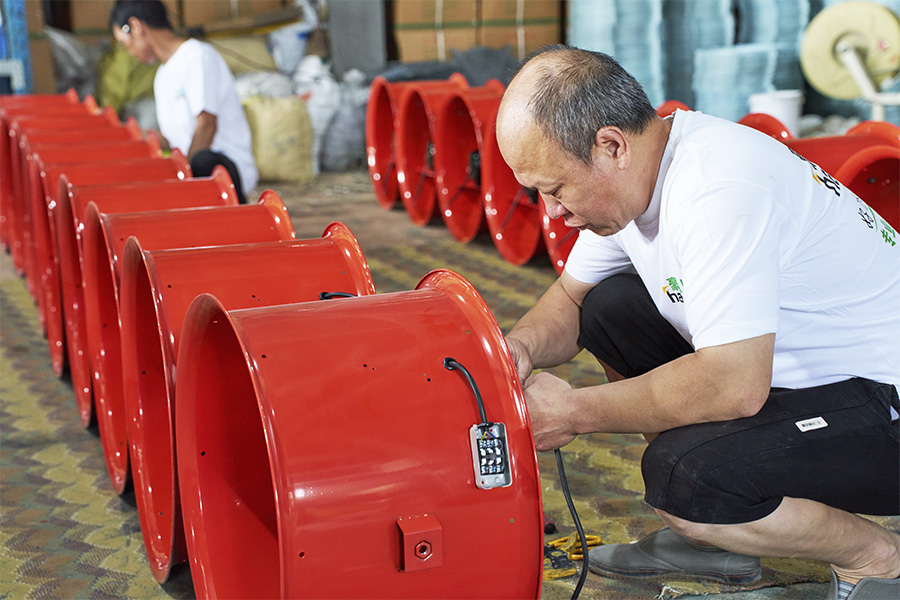Product
High Flow Axial Fan For Sale
Mixed flow fans combine the advantages of axial flow fans and centrifugal fans to form a unique fan structure and airflow characteristics. Its common characteristics include large air volume, moderate air pressure, high operating efficiency and low noise, which are suitable for ventilation needs in a variety of complex environments.
The mixed flow fan adopts a spiral blade design, which can achieve a strong airflow driving force in a small space, combining the high flow of axial flow fans and the high pressure capacity of centrifugal fans.
The advantages of HAOBA mixed flow fans are mainly reflected in compact structure, stable performance, energy saving and environmental protection, and easy maintenance. It is particularly suitable for use in occasions with limited ventilation ducts and comprehensive requirements for wind pressure and air volume. It is widely used in industrial plants, underground parking lots, tunnel ventilation, air conditioning systems, mines and tunnel exhaust, etc.
With outstanding performance and reliable quality, HAOBA mixed flow fans have a good reputation and competitiveness in the market, meeting customers' diverse ventilation solution needs.

-
Jan 02, 2026_HaoBaSelecting the Correct fan is crucial for achieving effective ventilation in industrial and commercial spaces. High flow ...Read More
-
Dec 26, 2025_HaoBaThe use of guide vanes in vane axial flow fans effectively boosts static pressure, improves airflow stability, and enhan...Read More
-
Dec 19, 2025_HaoBaFor industrial ventilation systems, proper maintenance of vane axial flow fan is crucial to sustain airflow efficiency, ...Read More
-
Dec 16, 2025_HaoBaTaizhou Haoba Electromechanical Co., Ltd., a manufacturer of advanced ventilation equipment, proudly participated in the...Read More
Mixed Flow Fan Industry Knowledge Extension
Mixed Flow Duct Fan: Balancing Pressure and Efficiency
The mixed flow duct fan is a practical solution in ventilation systems where moderate pressure and airflow are required. It combines the design features of both axial and centrifugal fans, allowing it to produce higher static pressure than a typical axial fan while maintaining a more compact shape than a centrifugal alternative. This unique balance makes it suitable for use in ducted systems found in commercial, industrial, and agricultural applications.
In real-world use, mixed flow duct fans are often installed in HVAC systems, workshops, grow rooms, or any place where long duct runs can reduce airflow. Their hybrid blade design enables them to move air more effectively through resistance without the need for excessive motor power. This results in energy savings and consistent performance, especially in environments where air has to travel through filters, silencers, or bends in ductwork.
The compact housing of a mixed flow duct fan makes it easier to install in tight spaces compared to centrifugal units, and the noise level remains relatively low, making it suitable for indoor settings. With various models available across different sizes and airflow ranges, these fans offer a flexible ventilation option across multiple industries.
Mixed Flow Fan: A Hybrid Approach to Air Movement
The mixed flow fan, often confused with its ducted counterpart, is a broader category that includes various configurations meant for applications ranging from cooling equipment enclosures to industrial exhaust systems. At its core, the mixed flow fan utilizes aerodynamic blades positioned at an angle between that of axial and centrifugal types. This allows it to push air in a more directional manner than centrifugal fans but with greater pressure capacity than a standard axial fan.
These fans are often used where airflow performance and space limitations intersect. For instance, in manufacturing facilities or electronic enclosures, maintaining a steady air supply while dealing with tight compartments can be a challenge. The mixed flow fan provides a middle-ground solution by delivering reliable air movement without occupying a large footprint.
One advantage of the mixed flow design is its ability to maintain stable airflow against resistance. Whether it's in a filter bank or a plenum, the fan can adapt to environmental backpressure while delivering predictable results. It is also known for operating more quietly than a similar-sized centrifugal fan, making it a go-to option when both airflow and acoustic performance are important.
High Flow Axial Fan: Designed for Volume and Speed
High flow axial fans are built to move large volumes of air quickly and efficiently. Their straight-through airflow path and large blade diameters allow them to generate strong air currents, making them ideal for applications where high airflow rates are necessary without the need for elevated static pressure. These include warehouse cooling, greenhouse ventilation, server room exhaust, and equipment cooling systems.
The primary appeal of a high flow axial fan lies in its simplicity and effectiveness. The blades are mounted directly on the motor shaft or hub and rotate in a single plane, pulling or pushing air through the system. With minimal airflow resistance, these fans excel in environments where the primary goal is to circulate air across open spaces or along unrestricted pathways.
High flow axial fans are commonly mounted on walls, ceilings, or as part of ventilation hoods. Their direct and linear airflow makes them suitable for removing heat, smoke, or moisture from enclosed areas, especially in large industrial or agricultural buildings. Because of their straightforward design, they are also easy to maintain and repair, which adds to their practicality.
Noise levels vary depending on blade size and speed, but advancements in blade geometry and motor technology have helped improve acoustic performance without sacrificing airflow. Some versions of high flow axial fans also come with adjustable pitch blades or speed controls to fine-tune performance depending on seasonal or operational needs.

 English
English русский
русский عربى
عربى












